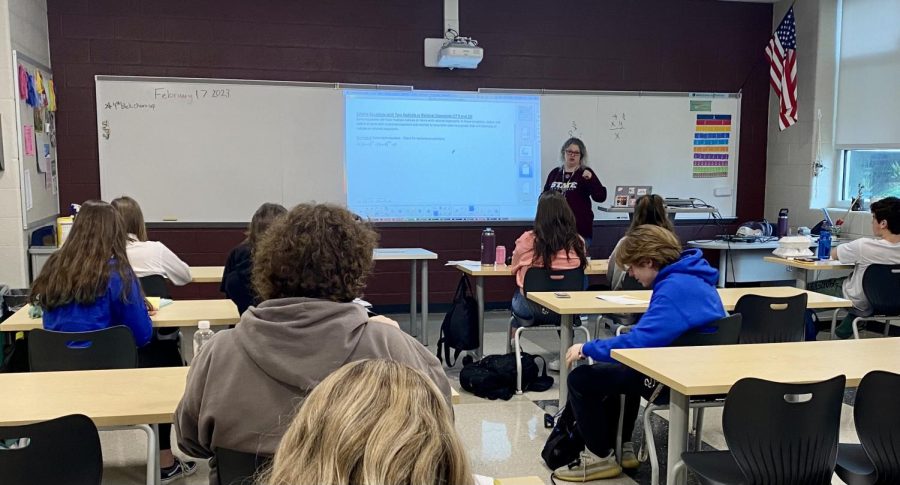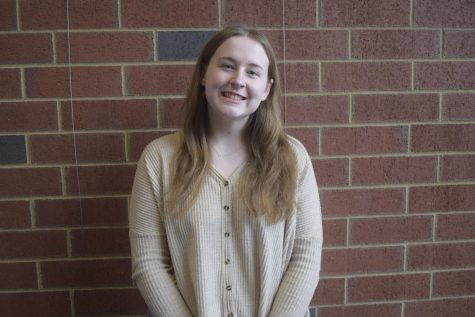The Lack of Additional Support in State High Math Programs
Block 4, CP Algebra 2 students taking notes about radicals and exponents while listening to a lecture given by teacher Shelly Soltis. There was no additional support in this 4th block class and Soltis shares her support for more assistance. “I think that anytime you have more people to help and be able to split the students up, it’s helpful,” Soltis stated.
February 19, 2023
The SCASD mission statement is “To prepare students for lifelong success through excellence in education,” but what excellence is there to be reached when teachers are too busy to help out?
It’s a well known feeling: raising your hand for what seems like ages in math class because you don’t understand how to solve for ‘X’, or what a ‘special right triangle’ is supposed to signify. The teacher – who appears overwhelmed – gives a quick three-worded answer so that they can move on to the next person. And, those three words typically don’t signify comprehension, so one is left to struggle on their own.
With available time, one might be able to get help from the math center or the Lion’s Learning Lounge, which are both opportunities happening during or after school. However, for students who engage in multiple extracurricular activities – things that SCAHS pushes all students to get involved with – or have a full schedule, many don’t have the time to access that help.
It’s time for State High to push for additional support in their math classrooms – specifically those that are full or almost full.
Lily Ruocco is a junior at State High who knows all too well how frustrating it can be trying to get help in large classes; her precalculus class has about 26 kids in it.
“Everybody’s confused and there’s just not enough time and resources to ask our questions and get a good explanation…It’s hard getting help in [math class] because either the answers are too short to be helpful, or there just isn’t time for me to even bother asking,” Ruocco said.
Ruocco believes that having additional teaching support would have a positive impact on student learning, and not to mention, make teachers less overwhelmed.
Shelly Soltis is a State High math teacher who has already felt the difference between having an extra set of hands versus teaching without assistance.
Soltis has been teaching at State High for many years and currently teaches three math courses: Advanced Geometry, CP Algebra 2, and a senior-level Math Seminar. The geometry and algebra classes each have about 25 students in them, while the seminar class has 10. This school year, Soltis gets to have the experience of teaching with (and training) a Penn State student-teacher. The student-teacher, referred to as Miss Julie by students, has been assisting Soltis in most of her courses since last semester, and will continue to teach alongside Soltis until the end of April.
“My student teacher right now is with me in all the classes which is awesome…I don’t know about [a drastic change in] grades, but it’s definitely helpful to have another set of hands to help with getting to all of the students when they have questions,” Soltis said with regard to her right hand.
Having additional teachers in the classroom also puts students in a less stressful mood and guides them to not get behind in class.
CP Algebra 1 A/B is an everyday math course designed for primarily freshmen who need a little extra help in order to pass their Algebra 1 Keystone exam. Freshmen River Alves and Hayley Shade are students enrolled in this course who say that it only takes around 30 seconds to receive adequate help on their work. This is because this algebra class is often full of teaching assistants (TA’s). TA’s are older students who have previously taken that course and want to receive elective credit by helping out other students.
“It’s helpful to have older people who have already learned all the stuff that we’re learning and help us get through it. They know what it’s like to be in our shoes,” Shade said when explaining why she finds having teaching assistants helpful.
Additional teaching support is critical in any math classroom above 20 students. Not just for the students to be able to keep up with the workload given, but also to give the teachers a bit of a break when trying to support students. State High administration should be advertising more on TA-ing and dividing up paraprofessionals evenly based on class sizes.
If you are a sophomore or up, you can take action by contacting your current or past math teachers about being able to TA and receive elective credit for your work.



